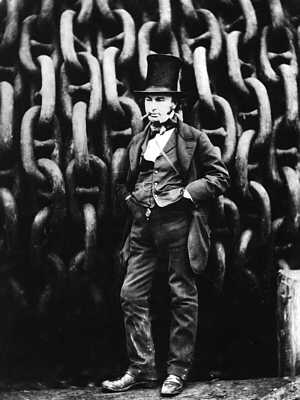Engine assembly on a large scale..
Discussion
Amazing stuff!
Right, I am going to open myself up here to a whole load of grief.
I get that this is essentially a huge engine block, the crank, head etc etc, but what about the other stuff we take for granted on an engine?
Explain how things like the alternator / coil are handled. How do you fuel it and what with? What about it's spark plugs? Does it have any carbs?
I hope I am only asking what others are thinking!
Right, I am going to open myself up here to a whole load of grief.
I get that this is essentially a huge engine block, the crank, head etc etc, but what about the other stuff we take for granted on an engine?
Explain how things like the alternator / coil are handled. How do you fuel it and what with? What about it's spark plugs? Does it have any carbs?
I hope I am only asking what others are thinking!
tossbag said:
Amazing stuff!
Right, I am going to open myself up here to a whole load of grief.
I get that this is essentially a huge engine block, the crank, head etc etc, but what about the other stuff we take for granted on an engine?
Explain how things like the alternator / coil are handled. How do you fuel it and what with? What about it's spark plugs? Does it have any carbs?
I hope I am only asking what others are thinking!
Its a diesel at a guess so you dont need a coil/plugs etc.... and would run on industrial fuel which is like treacle..... Started by using a smaller engine to generate compressed air at a guess, to get it moving....Right, I am going to open myself up here to a whole load of grief.
I get that this is essentially a huge engine block, the crank, head etc etc, but what about the other stuff we take for granted on an engine?
Explain how things like the alternator / coil are handled. How do you fuel it and what with? What about it's spark plugs? Does it have any carbs?
I hope I am only asking what others are thinking!
I assume an industrial AC dynamo would be hooked up to the engine to recharge the battereies on the ship etc....
Edited by tegwin on Saturday 7th November 15:39
Found a more modern example produced in Japan:
http://people.bath.ac.uk/ccsshb/12cyl/
The Wartsila-Sulzer RTA96-C turbocharged two-stroke diesel engine is the most powerful and most efficient prime-mover in the world today. The Aioi Works of Japan's Diesel United, Ltd built the first engines and is where some of these pictures were taken.
It is available in 6 through 14 cylinder versions, all are inline engines. These engines were designed primarily for very large container ships. Ship owners like a single engine/single propeller design and the new generation of larger container ships needed a bigger engine to propel them.
The cylinder bore is just under 38" and the stroke is just over 98". Each cylinder displaces 111,143 cubic inches (1820 liters) and produces 7780 horsepower. Total displacement comes out to 1,556,002 cubic inches (25,480 liters) for the fourteen cylinder version.
Some facts on the 14 cylinder version:
Total engine weight: 2300 tons (The crankshaft alone weighs 300 tons.)
Length: 89 feet
Height: 44 feet
Maximum power: 108,920 hp at 102 rpm
Maximum torque: 5,608,312 lb/ft at 102rpm
Fuel consumption at maximum power is 0.278 lbs per hp per hour (Brake Specific Fuel Consumption). Fuel consumption at maximum economy is 0.260 lbs/hp/hour. At maximum economy the engine exceeds 50% thermal efficiency. That is, more than 50% of the energy in the fuel in converted to motion.
For comparison, most automotive and small aircraft engines have BSFC figures in the 0.40-0.60 lbs/hp/hr range and 25-30% thermal efficiency range.
Even at its most efficient power setting, the big 14 consumes 1,660 gallons of heavy fuel oil per hour

http://people.bath.ac.uk/ccsshb/12cyl/
The Wartsila-Sulzer RTA96-C turbocharged two-stroke diesel engine is the most powerful and most efficient prime-mover in the world today. The Aioi Works of Japan's Diesel United, Ltd built the first engines and is where some of these pictures were taken.
It is available in 6 through 14 cylinder versions, all are inline engines. These engines were designed primarily for very large container ships. Ship owners like a single engine/single propeller design and the new generation of larger container ships needed a bigger engine to propel them.
The cylinder bore is just under 38" and the stroke is just over 98". Each cylinder displaces 111,143 cubic inches (1820 liters) and produces 7780 horsepower. Total displacement comes out to 1,556,002 cubic inches (25,480 liters) for the fourteen cylinder version.
Some facts on the 14 cylinder version:
Total engine weight: 2300 tons (The crankshaft alone weighs 300 tons.)
Length: 89 feet
Height: 44 feet
Maximum power: 108,920 hp at 102 rpm
Maximum torque: 5,608,312 lb/ft at 102rpm
Fuel consumption at maximum power is 0.278 lbs per hp per hour (Brake Specific Fuel Consumption). Fuel consumption at maximum economy is 0.260 lbs/hp/hour. At maximum economy the engine exceeds 50% thermal efficiency. That is, more than 50% of the energy in the fuel in converted to motion.
For comparison, most automotive and small aircraft engines have BSFC figures in the 0.40-0.60 lbs/hp/hr range and 25-30% thermal efficiency range.
Even at its most efficient power setting, the big 14 consumes 1,660 gallons of heavy fuel oil per hour

Edited by EINSIGN on Saturday 7th November 17:24
tegwin said:
tossbag said:
Amazing stuff!
Right, I am going to open myself up here to a whole load of grief.
I get that this is essentially a huge engine block, the crank, head etc etc, but what about the other stuff we take for granted on an engine?
Explain how things like the alternator / coil are handled. How do you fuel it and what with? What about it's spark plugs? Does it have any carbs?
I hope I am only asking what others are thinking!
Its a diesel at a guess so you dont need a coil/plugs etc.... and would run on industrial fuel which is like treacle..... Started by using a smaller engine to generate compressed air at a guess, to get it moving....Right, I am going to open myself up here to a whole load of grief.
I get that this is essentially a huge engine block, the crank, head etc etc, but what about the other stuff we take for granted on an engine?
Explain how things like the alternator / coil are handled. How do you fuel it and what with? What about it's spark plugs? Does it have any carbs?
I hope I am only asking what others are thinking!
I assume an industrial AC dynamo would be hooked up to the engine to recharge the battereies on the ship etc....
Edited by tegwin on Saturday 7th November 15:39
TheEnd said:
Does anyone have much experience of that gas torch the crank was cut with?
I'm amazed you can direct a jet down from the top, and it'll cut straight line down 2 foot!
It is an oxy acetylne profile cutter. I used to use them when I was in the factories in the 70's and 80's. You're right, it is amazing that they can cut so neatly and so deep.I'm amazed you can direct a jet down from the top, and it'll cut straight line down 2 foot!
The oxygen/acetylene flame heats the steel to red heat, and then a thin stream of pure oxygen jets into it, oxidising the metal away, rather than the oft thought mistake that it is simply blasting away the melted metal. [/nerd]
Pesty said:
I wonder how much pressure this guy is under. The crank is almost fully assembled and he is doing some machine cutting I think.
One slip and he not the most popular man in the factory
If he did slip up, I'm sure they'd have been able to repair it ... probably build it back up with weld and recut it, or whatever the equivalent is at this scale ... I've a vague recollection of a process where atomised molten steel particles can be sprayed/attracted to a metal part, building it up that way too (I'm sure someone on here will know it's name)One slip and he not the most popular man in the factory
EINSIGN said:
Celt said:
lol CNC forums!
Yes I know it’s a bit nerdy, but I have been searching around for dxf sample files to use with the new router machine I am having installed this month. One of the first sample tests we will be making is this T-Rex, to give to some of our customers before Christmas:

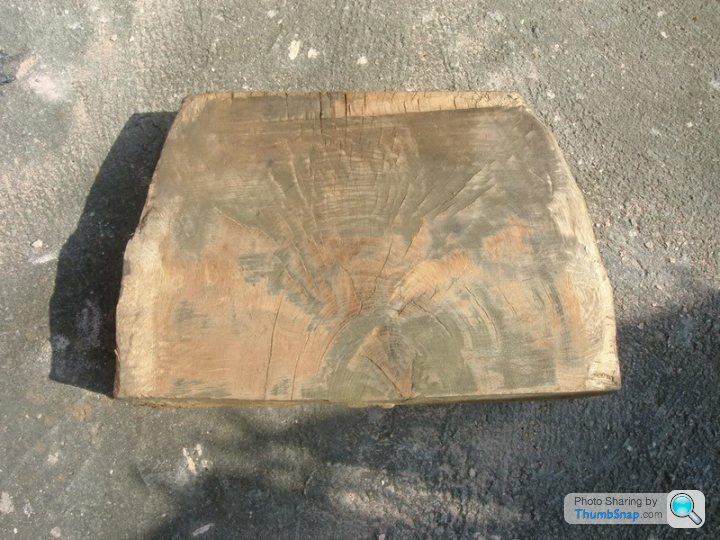
[url]
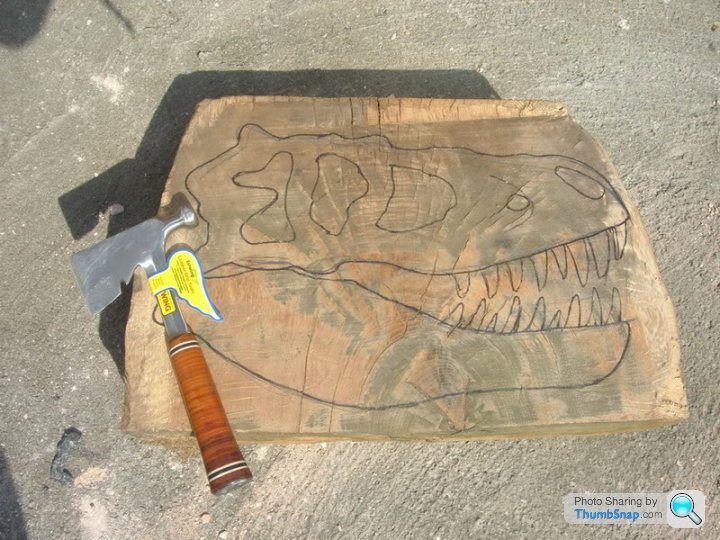 |http://thumbsnap.com
|http://thumbsnap.com/v/CVcN6tvM.jpg[/url]
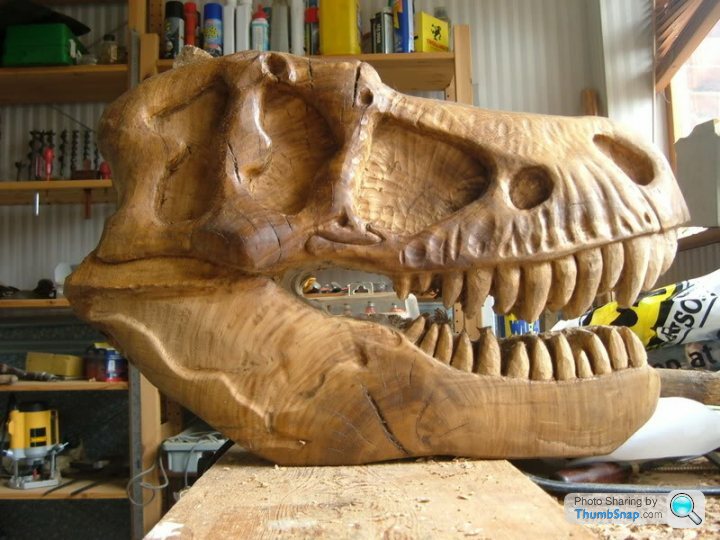
tossbag said:
tegwin said:
tossbag said:
Amazing stuff!
Right, I am going to open myself up here to a whole load of grief.
I get that this is essentially a huge engine block, the crank, head etc etc, but what about the other stuff we take for granted on an engine?
Explain how things like the alternator / coil are handled. How do you fuel it and what with? What about it's spark plugs? Does it have any carbs?
I hope I am only asking what others are thinking!
Its a diesel at a guess so you dont need a coil/plugs etc.... and would run on industrial fuel which is like treacle..... Started by using a smaller engine to generate compressed air at a guess, to get it moving....Right, I am going to open myself up here to a whole load of grief.
I get that this is essentially a huge engine block, the crank, head etc etc, but what about the other stuff we take for granted on an engine?
Explain how things like the alternator / coil are handled. How do you fuel it and what with? What about it's spark plugs? Does it have any carbs?
I hope I am only asking what others are thinking!
I assume an industrial AC dynamo would be hooked up to the engine to recharge the battereies on the ship etc....
Edited by tegwin on Saturday 7th November 15:39
Power for the ship comes from shaft alternators (for when the propellor shaft is turning) or from diesel generators (for when the shaft isn't turning). Batteries are for emergencies only, i.e. if you lose all power, including the emergency generator, which should kick in in the event of a blackout. In this case, only certain systems and lighting circuits will be powered.
Compressed air for engine starting is produced by compressors driven by electric motors, and stored in pressure vessels to allow for multiple 'shots' of air for engine starts.
On the subject of the Wartsila engine shown a few posts above (built in Japan, but Wartsila is a Finnish company), here are the workers fitting the 'thin' shell bearings, and the actual class of ship that the engine powers:
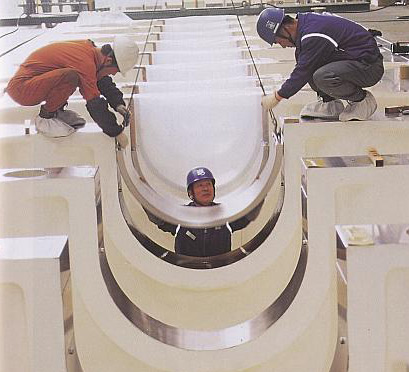

Gassing Station | Boats, Planes & Trains | Top of Page | What's New | My Stuff







